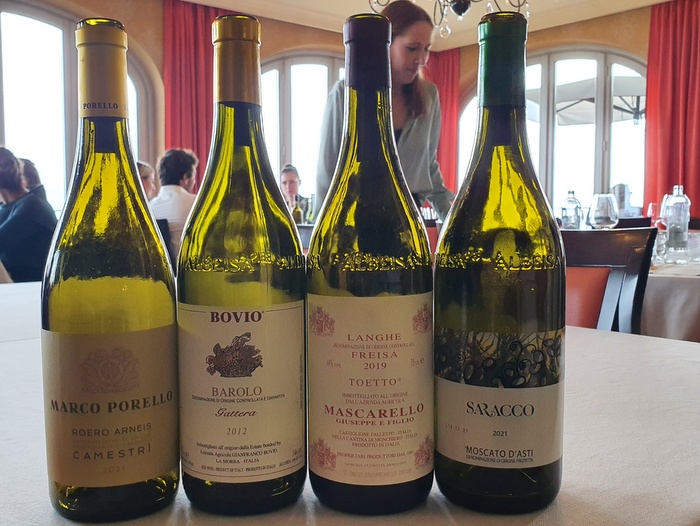Piedmont is a highly prestigious wine region both at a national and international level. It is home to a number of key native grape varieties, many of which are not widely grown outside the region. Located in the foothills of the Alps, Piedmont’s vineyards enjoy optimal sunshine by day and cooler temperatures by night and the region has a diverse soil selection. Amongst the people of Piedmont there is a deep-rooted wine culture, including centuries-old family estates and modern producers blending tradition with innovation. In short, Piedmont offers the perfect marriage of naturally advantageous landscapes and cultural dedication, producing wines that are both powerful and refined. Hikers on our Jewels of Piedmont, France and the Maritime Alps and Italian Alps tours will all have the chance to taste the excellent wines from this area.

Key White Grapes from Piedmont
Arneis – The key white grape of Roero, offering floral and stone fruit aromas.
Cortese – The grape of Gavi making crisp, citrusy, and mineral-driven wines.
Favorita – this grape is a close relative of Vermentino which grows well in Liguria and Sardinia and produces light, fresh wines with citrus, pear and herbal notes.
Erbaluce – Found mostly in northern Piedmont, especially in Caluso north of Turin.
Moscato Bianco – One of the most traditional and iconic grapes in the region. Although grown all over Italy, it adapted exceptionally well to the hills of Asti, leading to the fame of Moscato d’Asti and Asti Spumante.

Key Red Grapes from Piedmont
Nebbiolo – The star of Piedmont, used in the wines of Barolo and Barbaresco. Produces powerful, long-lived wines with high tannins and acidity.
Barbera – More widely planted than Nebbiolo, wines from Barbera d’Asti and Barbera d’Alba are juicy, with vibrant acidity and lower tannins.
Dolcetto – Lighter and fruitier than Nebbiolo and Barbera, this grape is popular in Dolcetto d’Alba, Dolcetto di Dogliani, and Dolcetto di Ovada.
Freisa – One of Piedmont’s oldest varieties, this grape produces spicy, tannic reds, often with a slight fizz.

Top Wine Denominations in Piedmont
Barolo – “The Wine of Kings and the King of Wine”. This is a wine of remarkable structure, well suited to ageing and made only of Nebbiolo grapes. Must be aged for at least 3 years before release.
Barbaresco – Also made with 100% Nebbiolo grapes, with similar qualities to the Barolo, these wines are aged a minimum of 2 years.
Barbera d’Asti & Barbera del Monferrato Superiore – Fruity, vibrant and richly drinkable, elegant reds
Dolcetto – Three provinces are particularly highly prized: Diano d’Alba, Dogliani and Ovada. These are fruity, approachable reds with violet or ruby-red colour.
Gattinara & Ghemme – Nebbiolo-based reds from northern Piedmont with great ageing potential. Hidden gems for Nebbiolo lovers.
Roero – For both Nebbiolo reds and Arneis whites, which are aromatic wines with delicate floral and peachy aromas.
Gavi – Crisp, mineral white wines made from the Cortese grape. Best examples come from Gavi and its surrounding villages.
Asti and Moscato d’Asti – Sweet sparkling wine made from Moscato Bianco, including Asti Spumante.
Erbaluce di Caluso – Northern Piedmont white, often made as dry, sparkling, or passito sweet wines.
Wine Tip

If you are travelling in Piedmont then head for the tiny village of Pollenzo. This is home to Italy’s University of Gastronomic Sciences and, within this 19th century complex, you’ll find the “Banca del Vino”. Literally translated as The Wine Bank, this unique project came to life to curate a comprehensive library of Italian wine.
Founded by Carlo Petrini of the global Slow Food movement, the Wine Bank’s aim is to create a reference point for quality Italian wine from all over the country, to improve its global image and to preserve examples of the best bottles. Petrini knew that some winemakers did not have space to store their bottles on-site while the ageing process took place and often sent them to market before they reached optimum maturation. In the Wine Bank the wines have time to reach their full potential. Emphasis is given to winemakers who use traditional techniques, respect the environment and protect the incredible biodiversity of Italy’s different grape varieties. There are more than 100,000 bottles here from around 300 different producers. We visit the Banca del Vino on our Jewels of Piedmont tour.
